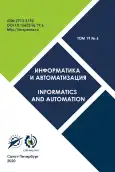卷 19, 编号 6 (2020)
Mathematical modeling and applied mathematics
Justification and Classification of Evaluation Fused in Rating Methods of Multi-criteria Choice
摘要
 1131-1165
1131-1165


Mathematical Model of Object Classifier based on Bayesian Approach
摘要
 1166-1197
1166-1197


New Method for Optimal Feature Set Reduction
摘要
A problem of searching a minimum-size feature set to use in distribution of multidimensional objects in classes, for instance with the help of classifying trees, is considered. It has an important value in developing high speed and accuracy classifying systems. A short comparative review of existing approaches is given. Formally, the problem is formulated as finding a minimum-size (minimum weighted sum) covering set of discriminating 0,1-matrix, which is used to represent capabilities of the features to distinguish between each pair of objects belonging to different classes. There is given a way to build a discriminating 0,1-matrix. On the basis of the common solving principle, called the group resolution principle, the following problems are formulated and solved: finding an exact minimum-size feature set; finding a feature set with minimum total weight among all the minimum-size feature sets (the feature weights may be defined by the known methods, e.g. the RELIEF method and its modifications); finding an optimal feature set with respect to fuzzy data and discriminating matrix elements belonging to diapason [0,1]; finding statistically optimal solution especially in the case of big data. Statistically optimal algorithm makes it possible to restrict computational time by a polynomial of the problem sizes and density of units in discriminating matrix and provides a probability of finding an exact solution close to 1. Thus, the paper suggests a common approach to finding a minimum-size feature set with peculiarities in problem formulation, which differs it from the known approaches. The paper contains a lot of illustrations for clarification aims. Some theoretical statements given in the paper are based on the previously published works. In the concluding part, the results of the experiments are presented, as well as the information on dimensionality reduction for the coverage problem for big datasets. Some promising directions of the outlined approach are noted, including working with incomplete and categorical data, integrating the control model into the data classification system.
 1198-1221
1198-1221


Artificial intelligence, knowledge and data engineering
Comparison of Two Objects Classification Techniques using Hidden Markov Models and Convolutional Neural Networks
摘要
This paper presents a comparison between discrete Hidden Markov Models and Convolutional Neural Networks for the image classification task. By fragmenting an image into sections, it is feasible to obtain vectors that represent visual features locally, but if a spatial sequence is established in a fixed way, it is possible to represent an image as a sequence of vectors. Using clustering techniques, we obtain an alphabet from said vectors and then symbol sequences are constructed to obtain a statistical model that represents a class of images. Hidden Markov Models, combined with quantization methods, can treat noise and distortions in observations for computer vision problems such as the classification of images with lighting and perspective changes.We have tested architectures based on three, six and nine hidden states favoring the detection speed and low memory usage. Also, two types of ensemble models were tested. We evaluated the precision of the proposed methods using a public domain data set, obtaining competitive results with respect to fine-tuned Convolutional Neural Networks, but using significantly less computing resources. This is of interest in the development of mobile robots with computers with limited battery life, but requiring the ability to detect and add new objects to their classification systems.
 1222-1254
1222-1254


Vietnamese Text Classification Algorithm using Long Short Term Memory and Word2Vec
摘要
In the context of the ongoing forth industrial revolution and fast computer science development the amount of textual information becomes huge. So, prior to applying the seemingly appropriate methodologies and techniques to the above data processing their nature and characteristics should be thoroughly analyzed and understood. At that, automatic text processing incorporated in the existing systems may facilitate many procedures. So far, text classification is one of the basic applications to natural language processing accounting for such factors as emotions’ analysis, subject labeling etc. In particular, the existing advancements in deep learning networks demonstrate that the proposed methods may fit the documents’ classifying, since they possess certain extra efficiency; for instance, they appeared to be effective for classifying texts in English. The thorough study revealed that practically no research effort was put into an expertise of the documents in Vietnamese language. In the scope of our study, there is not much research for documents in Vietnamese. The development of deep learning models for document classification has demonstrated certain improvements for texts in Vietnamese. Therefore, the use of long short term memory network with Word2vec is proposed to classify text that improves both performance and accuracy. The here developed approach when compared with other traditional methods demonstrated somewhat better results at classifying texts in Vietnamese language. The evaluation made over datasets in Vietnamese shows an accuracy of over 90%; also the proposed approach looks quite promising for real applications.
 1255-1279
1255-1279


Digital information telecommunication technologies
Empirical Approach to the Estimating the Immunity of Phase Modulation Signals with Continuous Phase
摘要
 1280-1306
1280-1306


Comparative Analysis of Centrality Measures of Network Nodes based on Principal Component Analysis
摘要
 1307-1331
1307-1331


Centrally Reserved Access Model to the Medium in Digital Radio Communication Networks
摘要
 1332-1356
1332-1356











